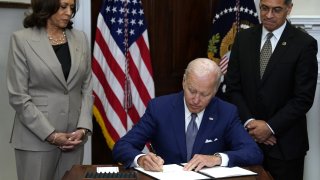President Joe Biden has signed executive orders on abortion rights, health insurance and the conflict in Ukraine this year.
Executive orders are a way for the president to accomplish their agenda, undo an action by a predecessor, or change how federal agencies act, experts say.
Throughout their terms, presidents can issue dozens of executive orders, sparking common questions about their effectiveness and whether they can be reversed. After Biden’s July order on abortion rights, Google searches with the terms “executive order” and “overturned” spiked.
This guide will answer some basic questions about executive orders and how they work.
What do executive orders do? Are executive orders laws?
An executive order is not quite a law, but has the weight of one. It’s up to Congress to pass laws that affect the people, and the courts to interpret them. When a president issues an executive order, it’s telling the agencies of the federal government how to act.
“They are ways in which the executive, the president, can direct what’s going on in the executive branch, but also in a way that has public relations significance,” said Richard Briffault, a Columbia Law School professor.
In Biden’s July order on abortion rights, he directed the Department of Health and Human Services to issue a report on efforts to protect medication abortion, guarantee access to contraception and IUDs, and expand education about reproduction. Another executive order signed in August is aimed at protecting people who travel for abortions.
Before telling agencies what to do, presidents need to make sure the agencies have that power. Otherwise, they risk the order being challenged.
“He can’t give them authority they don’t already have. He can direct them as to how to use the authority they do have,” Briffault said.
How are executive orders overturned?
Some executive orders, like Biden’s July order on abortion, are an expression of tension between branches of government. Biden said the Supreme Court was “out of control” when it overturned the 1973 Roe v. Wade decision protecting abortion rights. Biden also said he would veto any Republican Congressional effort to ban abortion nationwide.
But not every executive order sparks so much interest.
“Most of them fly under the radar,” said Brendan Beery, law professor at Western Michigan University. “They're a very common mechanism for a president to operate. There is a kernel of truth that sometimes a president will issue an executive order that pushes the limits. And the reason is that Congress won't do what the president wants to. And so the president's trying to do whatever he can by himself. ”
“The president can overturn his or her own executive order and the current president can undo a prior president's executive order,” Beery added. “They do that all the time, because they come in with different agendas.”
Executive orders can be challenged in federal courts, and judges can rule against them. If attorneys for the Department of Justice don’t get the ruling they want, they can ask judges for a stay — in effect, letting the order remain in place while appeals are underway.
During the legal battle over Trump’s order banning travel from several majority-Muslim countries, a judge stepped in and allowed travel to resume, denying government attorneys’ request to keep the order in effect during the appeals process.
“The judge said just, ‘no,’” Beery said. “This [ruling against the order] is immediate and I’m shutting this down across the entire country. So they have the discretion to do that.”
Is Joe Biden issuing more or fewer executive orders than past presidents?
Biden is keeping pace with other presidents when it comes to executive orders, experts say.
According to stats from the American Presidency Project, Franklin Delano Roosevelt issued executive orders the most, an average of 307 per year. Since FDR, presidents have averaged 61 per year, with more recent presidents trending lower. Barack Obama averaged 35 executive orders a year, and Donald Trump averaged 55.
Biden has issued an average of 63 executive orders per year.
But political mudslinging about a president’s use of executive orders is common in Washington.
“Every party bashes the other party for using executive orders. … They say, ‘well, the president's trying to make law… the president's out of his lane, he's trying to enact law without Congress,’” Beery said. “That's a little bit disingenuous because all presidents have used executive orders. And in fact, every president since George Washington has issued executive orders.”


